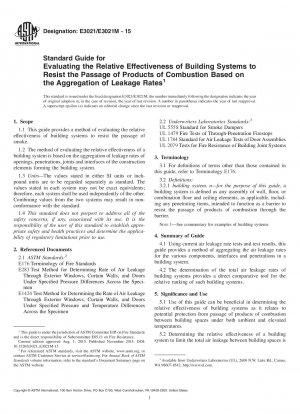ASTM E3021/E3021M-15
Standard Guide for Evaluating the Relative Effectiveness of Building Systems to Resist the Passage of Products of Combustion Based on the Aggregation of Leakage Rates
- Standard No.
- ASTM E3021/E3021M-15
- Release Date
- 2015
- Published By
- American Society for Testing and Materials (ASTM)
- Status
- Replace By
- ASTM E3021/E3021M-15(2019)
- Latest
- ASTM E3021/E3021M-15(2019)
- Scope
5.1 Use of this guide can be beneficial in determining the relative effectiveness of building systems as it relates to potential protection from passage of products of combustion between building spaces under both ambient and elevated temperatures.
5.2 Determining the relative effectiveness of a building system to limit the total air leakage between building spaces is important in the evaluation and selection of potential construction components to meet desired performance requirements for a building.
5.3 To properly assess the relative effectiveness of a building system’s total air leakage rate, a guide as to how to aggregate the individual component air leakage rates into a total air leakage rate for the building system is needed.
5.4 It is the intent of this guide to provide a methodology for the conversion of individual component air leakage rates into common values that can be aggregated into a total air leakage rate for a building system, thus providing a means for establishing the relative effectiveness of various building systems to resist the passage of products of combustion.
1.1 This guide provides a method of evaluating the relative effectiveness of building systems to resist the passage of smoke.
1.2 The method of evaluating the relative effectiveness of a building system is based on the aggregation of leakage rates of openings, penetrations, joints and interfaces of the construction elements forming the building system.
1.3 Units—The values stated in either SI units or inch-pound units are to be regarded separately as standard. The values stated in each system may not be exact equivalents; therefore, each system shall be used independently of the other. Combining values from the two systems may result in non-conformance with the standard.
1.4 This standard does not purport to address all of the safety concerns, if any, associated with its use. It is the responsibility of the user of this standard to establish appropriate safety and health practices and determine the applicability of regulatory limitations prior to use.
ASTM E3021/E3021M-15 Referenced Document
- ASTM E1424 Standard Test Method for Determining the Rate of Air Leakage Through Exterior Windows, Curtain Walls, and Doors Under Specified Pressure and Temperature Differences Across the Specimen
- ASTM E176 Standard Terminology of Fire Standards
- ASTM E283 Standard Test Method for Determining the Rate of Air Leakage Through Exterior Windows, Curtain Walls, and Doors Under Specified Pressure Differences Across the Specimen
ASTM E3021/E3021M-15 history
- 2019 ASTM E3021/E3021M-15(2019) Standard Guide for Evaluating the Relative Effectiveness of Building Systems to Resist the Passage of Products of Combustion Based on the Aggregation of Leakage Rates
- 2015 ASTM E3021/E3021M-15 Standard Guide for Evaluating the Relative Effectiveness of Building Systems to Resist the Passage of Products of Combustion Based on the Aggregation of Leakage Rates
